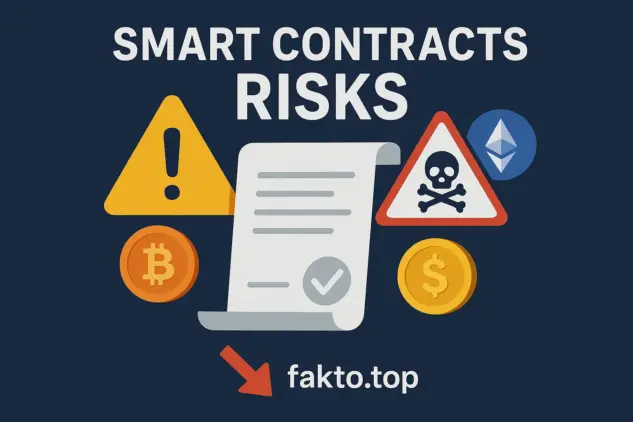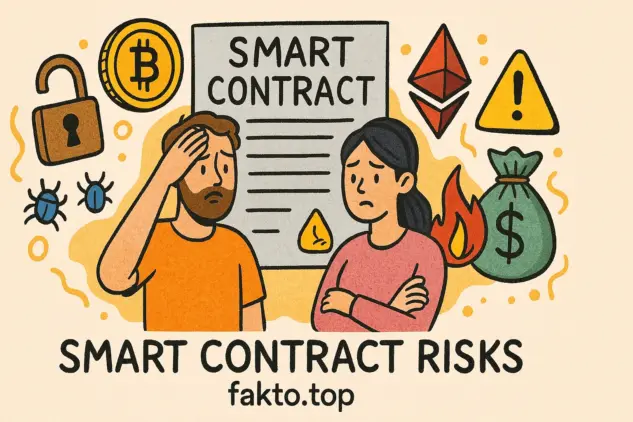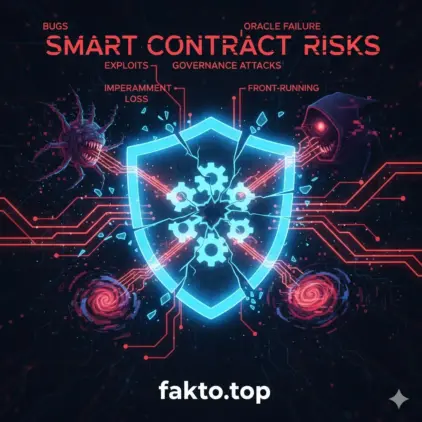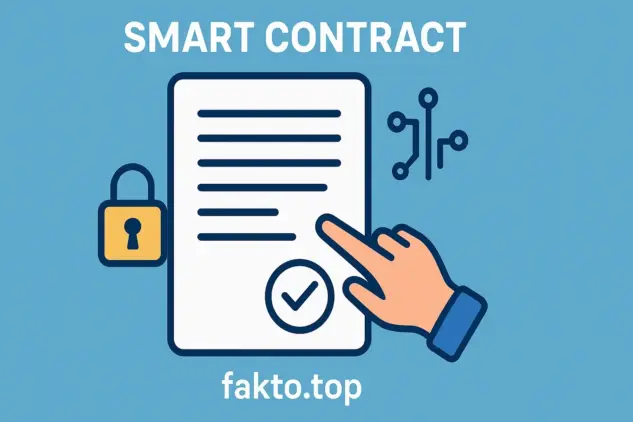Smart Contracts Risks: Vulnerabilities, Attacks, and Audit
Smart Contracts: The Risks and Nuances You Aren’t Told About
Guys, let’s be real. Smart contracts are everywhere in crypto and DeFi, promising automated, trustless transactions, yield farming, NFT sales, and more. Sounds sexy, right? But here’s the catch—2024 alone saw over $1.4 billion lost to exploits in smart contracts. And a lot of that happened because people treated “code is law” as a magic wand. Spoiler: it’s not.
Smart contracts are like robots that do exactly what you tell them to do. No judgment, no second chances, no mercy. One tiny typo, a small logic bug, or an overlooked attack vector can cost you your entire bag. And, unlike your favorite app, you can’t just push a patch.
So, what exactly are we dealing with? Let’s break it down, Q&A style, so you can actually understand the dangers and how to dodge them. By the end, you’ll see why a contract audit isn’t optional—it’s survival.
Disclaimer
Heads up! This article is for info and learning only. We’re not giving financial advice, and nothing here guarantees profits. Smart contracts are tricky, and you can lose some—or all—of your crypto if you’re not careful. Always read the docs, check audits, and think twice before ape-ing in. Your funds, your responsibility.
What is the ACTUAL biggest risk of using smart contracts?
The fundamental danger is immutability. Your contract is cemented. Cast in stone. Once deployed, the code is live forever. If there’s a flaw, you can’t just “fix” it. That’s what makes smart contracts a single point of failure.
Take the DAO hack of 2016. A reentrancy bug in the contract allowed an attacker to recursively withdraw funds. The DAO team couldn’t just update the code—Ethereum’s immutability meant the contract logic was untouchable. Millions of dollars vanished. Just imagine that feeling—applied to your own DeFi farm.
What if the code breaks? Can’t we patch it?
Generally, no. The code is locked, baked, and immutable. There are patterns like proxy contracts (Transparent or UUPS), which let you swap the contract logic while keeping the state. Sounds perfect, right? Well… not exactly.
Proxy patterns introduce centralization risks. The person holding the upgrade key can change rules at will—essentially pull a Rug Pull without touching the original contract. So while it adds flexibility, it also adds a huge target on your back. If that key gets compromised, guess who loses everything? Yup, everyone interacting with that contract.
Is contract security just about Reentrancy?
Nope. Reentrancy is just the tip of the iceberg. Smart contract hacks are getting sophisticated. The real threats are subtler:
- Oracle Manipulation: Hackers attack the data your contract relies on, not the contract itself. One bad price feed, and your DeFi position is toast.
- Flash Loan Attacks: Borrow billions for 5 minutes, manipulate the market, profit, return the loan. It’s legal, it’s on-chain, and yes, it’s terrifying.
Even if your code is flawless, if you trust bad data, you can still get wrecked.
Why do gas fees sometimes feel like daylight robbery?
Ah, gas. Not the stuff you fill in your car, but the crypto version that burns through your wallet faster than a flash loan attack. Every operation in a smart contract costs gas. The more complex your contract, the more gas you burn. And guess what? You pay for EVERY user interaction.

Remember Ethereum’s peak congestion in 2020? Gas fees for simple token transfers skyrocketed to over $50. That’s not an exaggeration. Inefficient code can turn a “cheap DeFi experiment” into a wallet-draining nightmare. So, optimizing your contract isn’t just a nice-to-have—it’s essential.
Can a smart contract run on a different blockchain (cross-chain)?
Short answer: no. You can’t just take your Ethereum contract and deploy it on Solana and expect it to work. Blockchains are like different operating systems. They speak similar languages but are fundamentally incompatible.
Cross-chain bridges exist to solve this, but let’s be honest—they’re some of the juiciest targets for hackers. Look at the Wormhole or Ronin hacks. The bridges were supposed to be trustless, but they ended up being the easiest way to steal millions. Moral of the story? If your contract depends on bridges, your risk profile just went through the roof.
What about data privacy in smart contracts?
Transparency is the name of the game in blockchain. But if you thought your transactions were private, think again. Every action is logged on a public ledger. Every token you moved, every swap you made—public. Everyone can see it. Even your “secret” DeFi strategy isn’t safe from on-chain detectives.
Some hope comes from Zero-Knowledge Proofs (ZK-proofs), which are being developed to allow contracts to verify data without revealing it. But ZK-tech is still niche and experimental. If privacy is your thing, you better double-check what you’re putting on-chain.

If the code throws an error, will it refund my tokens?
Here’s a trap many newbies fall into. Smart contracts do rollback on failure—so your tokens technically aren’t lost. But that gas fee? Gone. Poof. Burned. The contract realized it messed up, reverted the state, and left you paying for the “thinking process.”
Just imagine paying $30 gas to discover that your swap didn’t actually happen. Frustrating? Absolutely. Preventable? Sometimes, if the contract is well-audited and written efficiently.
Why does a proxy pattern not solve all risks?
We touched on proxies before. Sure, they allow upgrades, but think about it—who controls that upgrade key? If a centralized actor gets access, they can change rules, drain funds, or manipulate your contract with zero recourse. Upgradability is a double-edged sword: flexibility for developers, but potential disaster for users.
Smart Contract is Law, right? Can I sue if it goes wrong?
Let’s clear this up. On-chain, yes—code is law. The contract will execute exactly as written. Off-chain? Not so fast. Courts don’t automatically honor “it happened because the code said so.” Lawyers will argue intentions, external conditions, or even the Oracle that fed the contract. Translation: if you get hacked, suing the dev team or the protocol may not save you.
This is why many DeFi platforms pair smart contracts with legal wrappers—agreements off-chain that clarify rights, obligations, and responsibilities. It’s boring, paperworky stuff, but it’s essential if you don’t want to be the next Twitter thread about “lost millions in a smart contract mishap.”

Why do we use IPFS for data storage?
Smart contracts are not your cloud. You can’t just shove huge images, PDFs, or datasets directly into the blockchain. Storing data on-chain is ridiculously expensive and slow. Contracts are made for logic, not bulk storage.
Enter IPFS—a decentralized file system. Contracts can store a reference (hash) to data on IPFS. That way, your NFT’s image, or a DeFi report, stays accessible but doesn’t clog the blockchain or drain gas fees. Think of it as putting the heavy lifting off-chain while keeping the essential “pointer” on-chain.
How do Flash Loan Attacks work?
Flash loans are like the hacker’s Swiss Army knife. Borrow billions for a few minutes, manipulate a market, profit, return the loan—all in one atomic transaction. Legally, everything is fine; technically, you just witnessed a market crash orchestrated in seconds.
Even top-notch protocols have been caught off guard. Example: a DeFi platform’s token price was manipulated by a flash loan to exploit a vulnerability in the logic. Result? Millions drained in minutes. Moral of the story: if your contract logic can be gamed in a single transaction, it’s vulnerable.

What is Oracle Manipulation?
Smart contracts need data. Prices, weather conditions, sports results—you name it. That’s what Oracles provide. Hackers realized they don’t always need to touch the contract itself—they can just manipulate the Oracle feeding it. A wrong price input and your contract executes disastrous trades or liquidations.
Example: Suppose your contract liquidates positions if ETH < $1,900. If an attacker can temporarily feed $1,800 into the Oracle, they trigger unwanted liquidations, profit, and disappear, all while the code executed “correctly.” Genius and terrifying at the same time.
How do you avoid these attacks?
Good question. Here’s the quick checklist:
- Always Audit Smart Contract by professionals.
- Minimize trust in a single Oracle; use multiple sources or decentralized feeds.
- Stress-test your logic against Flash Loan scenarios.
- Consider implementing rate limits or circuit breakers for sensitive functions.
- Keep upgrades and keys as decentralized and secure as possible.
Guys, it’s not sexy, but understanding these things is your shield. If you ignore them, you’re basically leaving the door open with a neon sign: “Hack me.”
Are cross-chain bridges really safe?
Let’s not sugarcoat it. Cross-chain bridges are like tightropes over a pit of hungry hackers. They’re meant to let assets move between blockchains, but in reality, they’ve become some of the most exploited targets in crypto history.
Take Wormhole: $320 million drained because the bridge’s validation logic was flawed. Or Ronin, $625 million gone in one swoop. Users thought their funds were safe, but all it took was a single compromised key or misconfigured validator to empty accounts.
Bridges are inherently risky because they centralize trust in a few nodes or smart contract mechanisms. You thought you were “trustless”? Nope. You were just trusting the bridge operators not to screw up—or get hacked.

What infrastructure risks should you know?
Smart contracts don’t exist in a vacuum. They rely on nodes, validators, RPC providers, and Oracles. If any link in this chain is weak, your contract’s safety is compromised.
Example: Imagine a DeFi platform using a single RPC provider that goes offline or is censored. Suddenly, transactions fail, opportunities are missed, or worse—liquidations happen unintentionally. Infrastructure isn’t sexy, but it’s the backbone of security. Don’t ignore it.
Can bad UX or mismanagement cause losses too?
Absolutely. Users interact with contracts via interfaces, wallets, or dashboards. A confusing UI or wrong contract address can lead to catastrophic mistakes. One misplaced click, and your tokens are gone. Even the most secure smart contract can’t save users from human error.
Example: Users ape into a newly deployed token, copy-paste the wrong contract address, and “just like that,” funds vanish. A reminder: always double-check, triple-check, and maybe quadruple-check before you interact.
How do professional audits help?
Audits are your first line of defense. A good audit isn’t just a checkbox—it’s a deep dive into logic, edge cases, and attack vectors. Professional auditors simulate flash loan attacks, reentrancy, and Oracle manipulation to catch vulnerabilities before money hits the line.
But beware: audits aren’t bulletproof. Even audited contracts have been exploited. They reduce risk, they don’t eliminate it. Think of audits as helmets—not parachutes. You’re still responsible for how you interact with the contract.

Why knowing the nuances matters
Guys, understanding these risks isn’t about fear-mongering. It’s about survival in a world where billions move on immutable code. If you ignore these nuances, you’re basically playing Russian roulette with your crypto. Contracts are powerful, but they’re strict, unforgiving, and sometimes outright ruthless.
Even the best logic, audited and optimized, can fail if you ignore centralization of keys, bad Oracles, cross-chain vulnerabilities, or **human error**. Smart contracts reward knowledge, caution, and preparation.
The Reality Check: Smart Contracts Aren’t Toys
Alright, let’s lay it out straight. Smart contracts are powerful, yes. They can automate trades, manage NFT sales, run DeFi farms, and do things humans could never track manually. But they are strict robots—no mercy, no judgment. One logic flaw, one bad Oracle feed, or one compromised key can wipe out millions in minutes. And nobody’s coming to press “undo.”
Why every newbie and intermediate user should care
Look, we all love the hype. “GM, we’re going to the moon with yield farming!” But hype doesn’t pay your rent when a Flash Loan attack drains your wallet. Every time you interact with a smart contract, you’re playing on someone else’s rules—rules you might not fully understand. If you’re not thinking about Immutability, Oracle reliability, or upgrade centralization, you’re leaving your funds at serious risk.
Checklist to survive the smart contract jungle
- Audit Smart Contract: Never skip professional audits. They catch obvious flaws, even if they can’t foresee everything.
- Understand Proxies and Upgrade Keys: Know who controls upgrades. If it’s centralized, you’re exposed.
- Check your data sources: Oracles feed your contract. Bad data = disaster.
- Mind the gas: Inefficient contracts drain your wallet, even if nothing else goes wrong.
- Be careful with cross-chain interactions: Bridges are convenient but juicy hacker targets.
- Never ape in blindly: Read the docs, study the logic, and stay skeptical.
The Final Word
Here’s the bottom line, guys: smart contracts can make you money, automate crazy complex transactions, and open the door to a decentralized future. But they can also bankrupt you if you treat them like magic. One overlooked nuance, one typo, one exploited vulnerability, and your bag is gone.
Remember: Code is law on-chain—but off-chain, the legal system doesn’t automatically have your back. And even the most audited, optimized, carefully deployed contract has risks. There are no guarantees, only preparation, knowledge, and caution.
So don’t just ape in because a meme said “LFG!” Read the contracts, check the audits, think about proxies, oracles, and bridge vulnerabilities. Stay informed, stay skeptical, and stay alive in the wild world of DeFi. Your future self (and your wallet) will thank you.

